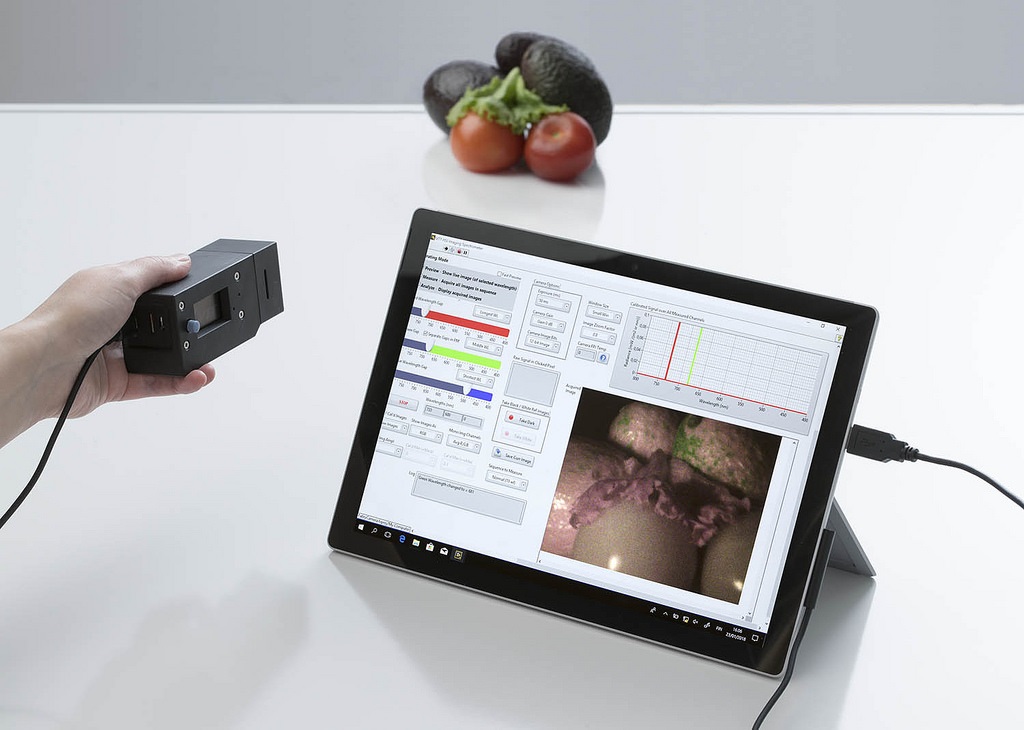26/01/2018
VTT Technical Research Centre of Finland has developed a highly cost-efficient hyperspectral imaging technology, which enables the introduction of new artificial intelligence applications into consumer devices. Spectral filtering technology takes advantage of the very-near-infrared (VNIR) wavelengths, which even low-cost mobile phone cameras can detect. Artificial intelligence can be used to interpret this environmental spectral data within images, which is not visible to the naked eye.
The developed hyperspectral camera uses VNIR wavelengths, which exceed the red colour seen by the human eye and are normally filtered out of standard camera images. The spectral data within the VNIR range enables detection and labelling of the materials and properties of different objects within the environment.
Spectral data of image objects generate information related e.g. to food safety or freshness, distinguishing between real and fake products, medicines, or security camera recordings. This information can be further utilized by wireless mobile applications created for sensor data interpretation. The facility can be integrated into our everyday surroundings to make them more intelligent, and incorporated into smart home systems and appliances, mobile devices, robots and autonomous vehicles, which need to interpret visual information in order to function securely.
"In future, an increasing share of vehicles and systems will become autonomous, and the need for reliable visual camera information for automated decision-making will increase. Adding the third spectral dimension to images could provide more safety and security for autonomous systems relying on machine vision and artificial intelligence to make decisions based on visual camera data", comments Anna Rissanen, Research Team Leader at VTT.
Currently, most hyperspectral imagers available on the market still cost from thousands to tens of thousands of dollars, which means they cannot be integrated for example into a smart fridge to measure food freshness. Other spectral imaging technologies, aiming towards mass-producible volume scaling in order to lower the final product cost, typically process fixed wavelength filters directly into individual camera sensor pixels. However, this approach has the bottleneck that it requires expensive telecentric optics.
"VTT's technology has a simple optical path, making it compatible even with the very compact and low-cost optics used in mobile cameras, which is not possible with other spectral imaging technologies. This is a huge advantage because it enables very cost-efficient mass production for these hyperspectral camera sensors", says Research Scientist Antti Näsilä.

Sensor core is a tiny tunable MOEMS wavelength filter of a few millimeters in size, integrated to small camera optics.
Credit: VTT
The bill-of-material cost for the new VNIR range (600 - 900 nm) hyperspectral camera sensor hardware sets a new low record of $150. With mass-producible MEMS technology, VTT's tuneable filter technology can also be integrated with any camera sensor without significantly increasing its cost or size; through high-volume production and calibration methods, the sensor cost including the camera optics could be <$20 and the core component, the micro-opto-electro-mechanical (MOEMS) chip, could cost less than one dollar.
The VTT team has in recent years pioneered the creation of hyperspectral imagers for the most demanding novel application fields by introducing the world's first visible- and SWIR hyperspectral imagers on space CubeSat missions, and diagnostic instruments for rapid skin cancer screening. Spectral sensing technologies developed by the team are already generating business for several companies, which have also created award-winning photonic sensor products.
During the next few years, VTT also aims to commercialize cost efficient hyperspectral imaging technologies in cooperation with companies operating in the field.















